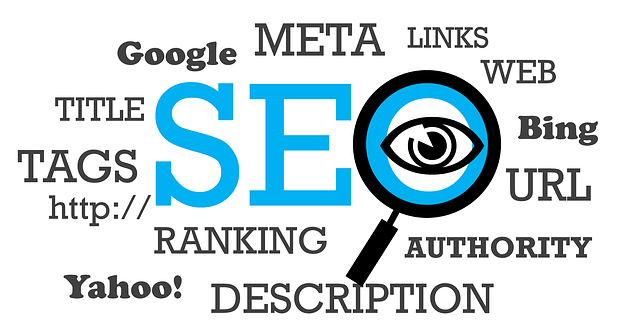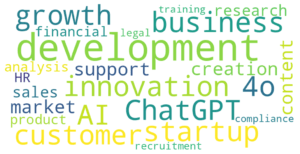Ranking highly on search engines can be difficult if you don’t approach your SEO strategically and methodically. It’s not the easiest thing to do, but that this SEO checklist for startups will help you overcome that hurdle to improve search engine rankings and drive traffic to your website.
This is especially true if you want to get free, recurring traffic. Your company will become more authoritative by having a blog that’s based around the type of product or service that you have, as well.
And if you don’t have a startup? Guess what? You’ll still find this list super helpful!
We have over 100 tips! They range from tips for WordPress sites to tips for any site (most are for the latter). It’s suggested to bookmark this or save it for later so you can go back to it.
While you’ll have to put in the elbow grease to enact most of these SEO checklist tips, search engine traffic is one of the best traffic sources out there. And that’s why we are providing you with this checklist today, so you can get on top of it and stay on top! And to stay on top, there are recurring activities that you’ll have to do. We show you what you need to do too.
So sit back and relax while you digest our 100 point SEO checklist for startups and, well, any other business.
Table of Contents
- Link Building
- Keyword Research
- Site Layout & Architecture
- Use Title Tags
- Meta Descriptions
- Header Tags
- The Content
- User Experience
- Google Search Console
- Google Analytics
- Site Speed
- Image Optimization
- Social Media
- Google Penalty Recovery
- Content Promotion
- General SEO Tips and Advice
- Recurring Activities
SEO Checklist for Startups
Improve your rankings and drive more traffic from the 100+ tips in these 17 sections.
1) Link Building
Link building is the single most important thing that you can do to increase your traffic and domain authority, after doing your keyword research, of course. White hat link building is when you do it organically, legally, and without payment. Black hat SEO is when you pay for and sell backlinks to and from other sites. White hat SEO is the best way to build backlinks. If you do black hat SEO, you may be heavily penalized. We share white hat strategies for SEO below.
Guest Posting on Relevant and High DA Websites
Identify relevant websites in your niche with high Domain Authority for guest posting opportunities. Guest posts with valuable content and links back to your site contribute to improved authority and search engine rankings.
Find Opportunities from Broken Links on Competitor’s Sites
Another method to build backlinks is to reach out to companies or bloggers who have an external link in their page or post that’s broken. Then offer your resource as an alternative to link to, and tell them why, providing the link to the article as well. In exchange, offer to share their post or page on social media and/or in your newsletter.
Although, you will only know if there are broken links by visiting the page or by inputting their post/page URLs in an SEO tool that analyzes them for broken links.
Find Broken Links and Backlinks Via:
- Ahrefs SEO Toolbar (a browser extension – make sure it’s pinned to your toolbar)
- Ahrefs Broken Link Building Guide
- SEMRUSH’s Guide & Tool for Finding Competitors Broken Backlinks
- SEMRUSH’s Backlink Analysis & Backlink Audit tools
- AI Backlink Building Tools – As of posting, there are 57 AI backlink tools listed in this collection by Top AI. Many of these tools help you automate your process of backlink building with automated email outreach, and more! Definitely recommend checking them out as options too. Please note: some of the AI listings are true backlink building tools, but some are not and provide variations of backlink building.
Use the Skyscraper Technique to Build Backlinks
In the competitive landscape of search engine rankings, content quality is paramount. Researching competitor posts allows you to identify gaps and create more comprehensive, valuable content. Then, you create content that’s way better and then try to get the entity that links to it to link to your content instead. This is skyscraper content, under the umbrella of the skyscraper technique. It’s also known as 10x content because it’s “10x” better than what’s out there now.
With this technique, you need to reach out to the bloggers and companies who link to the top posts, and ask them to share yours instead because it’s more comprehensive and their audience would value it more. You can offer to share their article/page that links to yours via social media and your email list, as well as your undying gratitude.
Did you know that pages with longer content tend to rank higher? Content exceeding 1,900 words receives, on average, 68.1% more tweets and 22.6% more Facebook likes.
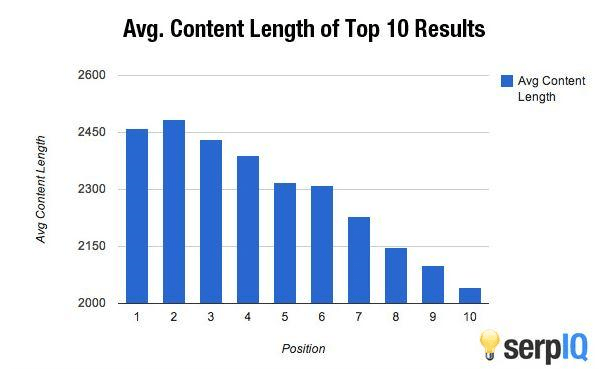
Focus on High Domain Authority (DA) Sites
Prioritize obtaining links from high Domain Authority (DA) sites. Backlinks from authoritative sites carry more weight in search engine algorithms. A study by Moz found a strong correlation between high DA and higher search engine rankings.
You can check domain authority on:
Strategic Internal and External Linking
Internally link to relevant content within your site to provide a seamless user experience. Linking to other pages of yours creates a stronger internal network of content that Google and other search engines will find to be more contextually relevant. As a result, it will find you as a greater authority on the subject matter and increase your domain authority.
To do this, there are a few methods:
- Create a list of all of your blog posts in a spreadsheet, then topically organize them. Then find content that is link worthy for you to mention. Open up the blog post and search for relevant keywords pertaining to each post. Add them so they are a natural fit.
- Search for a keyword in your CMS (content management system) and then go to the post/page that has it, and find a way to mention or link to it naturally. You don’t want to keyword stuff for irrelevant content.
- Create pillar pages that can serve as topical cornerstones for content of yours which will link out to all of the subtopics within that topic, like a table of contents would do. But it would be linking to other pages, not hyperlinks within the page itself.
Externally link to reputable sites that add value to your content. Google views well-linked content as more authoritative, positively impacting rankings. Don’t externally link to poor content.
Avoid Submitting to Directories
Submitting your site to general directories is no longer as effective for SEO. Google focuses on quality over quantity when it comes to backlinks. Directory links may not provide significant value and could even harm your site’s reputation.
2) Do Keyword Research
Conduct Comprehensive Keyword Research
Before delving into content creation, invest time in comprehensive keyword research. This foundational step ensures that your content aligns with what your target audience is actively searching for.
Did you know that 68% of online experiences begin with a search? By understanding the language your audience uses, you position your startup to meet their needs effectively.
Keyword Research Tools: Ahrefs, SEMRUSH, UberSuggest, Google Ads Keyword Planner
- Use Freemium/Paid Tools like Ahrefs, SEMRUSH, UberSuggest for competitor keyword research
- Explore and analyze the keywords your competitors are targeting to refine your own keyword strategy.
- Leverage the Google Ads Keyword Planner
- This free tool provides insights into keyword search volumes and competition, aiding in comprehensive keyword research. You just have to sign up for a Google Ads account. And you don’t even need to buy any ads to use the keyword planner! Check out this screenshot for planning our the keywords for this SEO checklist post.
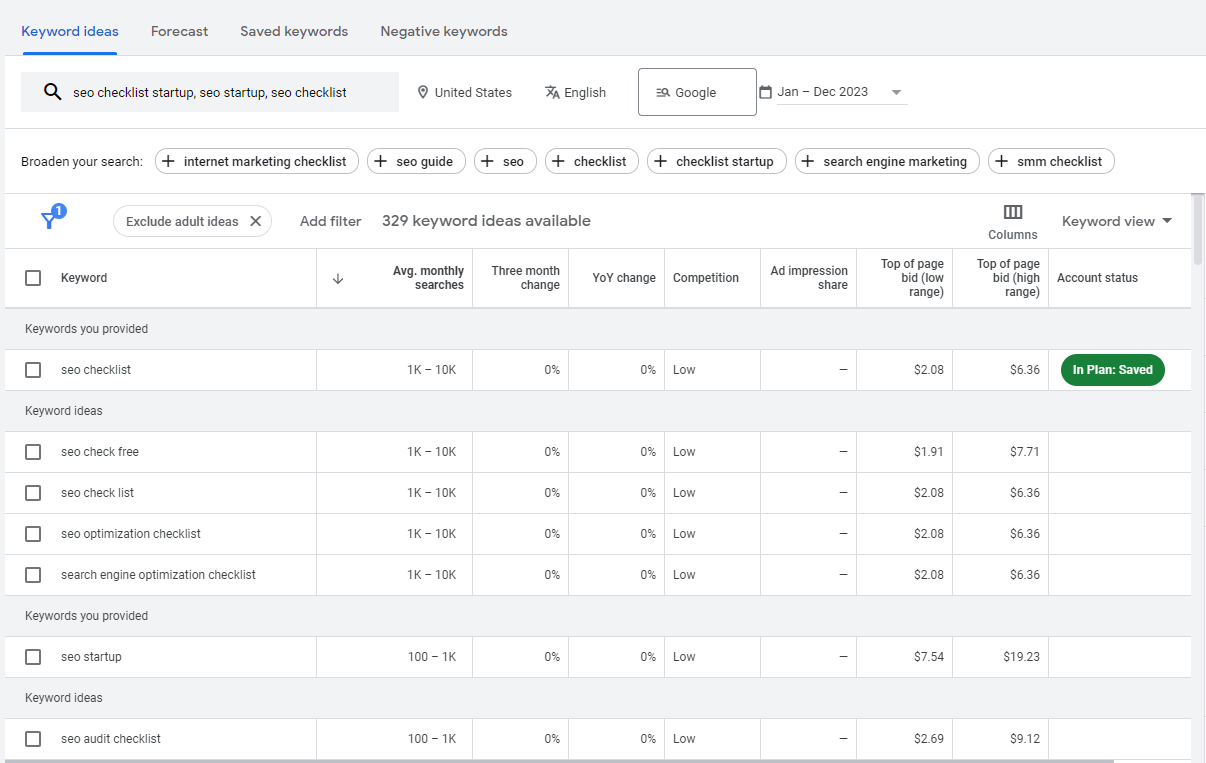
Utilize Long-Tail Keywords
Long-tail keywords, comprising three or more words, may have lower search volumes, but they boast higher conversion rates. Studies indicate that long-tail searches contribute to 70% of all web searches. These specific phrases connect your startup with users who are closer to making a decision or purchase.
What’s more, long-tail keywords are easier to rank for than two-word keywords. Basic keywords are usually dominated by websites with the highest domain authority, relevance, AND the best posts. They’re very hard to rank well in, compared to long-tail keywords, unless they’re from a very small niche.
Your Startup’s Keywords ⚡
Each startup belongs to a niche of some sort. It could be a huge niche or a small one, but a niche nonetheless.
Identifying and understanding the niche is crucial for startups because it allows them to tailor their offerings and marketing strategies to meet the unique demands of their target audience. This focus on a niche helps startups differentiate themselves in the market and can contribute to their overall success.
That being said, do the keyword research for your company’s niche. Learn what short keywords and long-tail keywords are the most used and target them.
Naturally use those keywords in on your homepage, in your about us page, your FAQ page, product offerings page, etc. Use them in headings and in body text and use variations of the words for latent semantic indexing.
Write Blog Posts Targeting Similar Keywords
Do Product Roundup Lists:
Let’s say you have a productivity tool as your startup’s offering. You can make a list of the 15 best productivity tools. But “productivity tool” is a basic keyword and hard to rank for. But maybe you have a tool that’s tailored to a specific audience, like your most specific type of user, who has very specific needs. Whether that’s a data engineer, marketer, founder, or whoever your exact user is. You would write the post title “the 15 best productivity tools for _____.”
You can do other posts of a similar nature, that include your industry long-tail keywords in them for guides and whatnot. This will help your startup gain more authority on the subject and provide helpful content for your ideal user.
Use Long-Tail Keywords for Voice Search
As voice search gains prominence, consider incorporating long-tail keywords that align with natural language queries. Voice-activated devices often respond better to conversational phrases.
You can incorporate them into your pages and posts through a question and answer format. Try asking questions that people would ask that pertain to the topic. Then provide a concise response.
Avoid Keyword Repetition
Repeating keywords across different pieces of content might seem like a strategy to reinforce relevance. However, Google’s algorithms prioritize diversity in content. Overusing the same keyword can lead to diminishing returns and, in some cases, penalization.
Incorporate User-Intent Keywords
Understanding user intent is crucial for delivering content that resonates. User-intent keywords align your content with the searcher’s goals.
Did you know that 64% of online shoppers say a search engine influences their purchase decision? Integrating user intent into your keyword strategy enhances the likelihood of attracting engaged visitors.
There are three stages of the buyer’s journey: awareness, consideration, and decision.
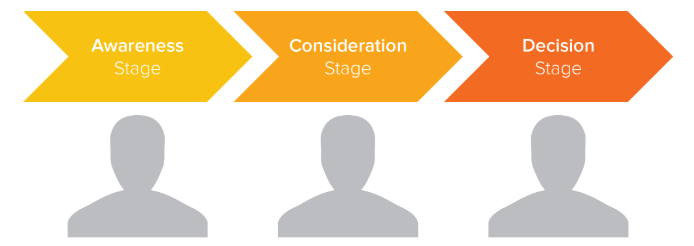
Integrate Keywords in Title and URL
The title and URL are prime real estate for your primary keyword. Incorporating the focus keyword in these crucial elements reinforces the relevance of your content to both users and search engines. Studies show that pages with an exact match keyword in the URL have a 45% higher click-through rate.
Avoid Keyword Stuffing
Keyword stuffing, once considered an SEO tactic, is now a red flag for search engines. Google’s algorithms prioritize content that provides value and a natural reading experience. Keyword stuffing not only diminishes user experience but can also result in penalties. Crafting content with contextual keyword usage ensures sustainable SEO performance.
3) Site Layout & Architecture Should be Clear and Upfront for SEO
Content Hierarchy and Navigation
Imagine your website as a well-organized book, with clear chapters and subchapters. A structured content hierarchy and easy navigation not only enhance user experience but also contribute to a lower bounce rate. Studies show that a one-second delay in page load time can result in a 7% reduction in conversions. Ensuring your visitors find what they’re looking for quickly can mitigate this risk.
Search Engine Friendly URLs
URLs are the digital addresses of your web pages. Including relevant keywords in your URLs not only aids search engines in understanding your content but also increases the likelihood of users clicking through. In fact, URLs with keywords have been shown to receive a 45% higher click-through rate.
Contact Info Accessibility
Accessible contact information builds trust with your audience. Did you know that websites with a clear and easy-to-find contact page can experience a 5% increase in conversions? However, it’s essential to protect your email from spam, and formatting it with spaces is a simple yet effective method.
Submit XML Sitemap to Google
Submitting an XML sitemap to Google is like providing a roadmap for search engine crawlers. Websites with submitted sitemaps are indexed faster, resulting in quicker visibility on search engine results pages. This can lead to a 30% increase in organic traffic within the first month.
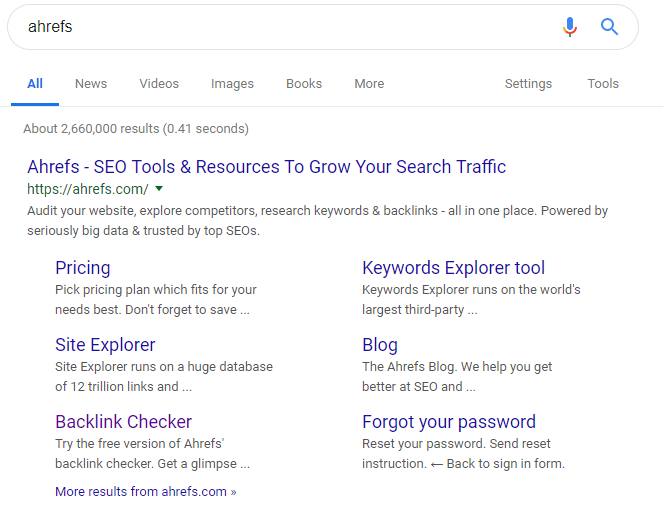
4) Use Title Tags
Title tags are what you view when scrolling over your browser’s tabs.
Keep Your Keyword in the Front
Title tags play a pivotal role in both SEO and user experience. Placing your focus keyword near the beginning of the title enhances visibility and relevance. Studies show that titles with the keyword placed at the front have a 15% higher click-through rate.
Avoid Truncation
Long titles risk truncation in search results, affecting click-through rates. Keeping your titles concise, ideally between 50-60 characters, ensures that they display fully. This optimization strategy contributes to a 20% higher likelihood of users clicking on your content.
Make It Clickable, but Not Like Clickbait and Not Deceptive
While a clickable title is essential, it’s equally crucial to maintain transparency. Clickbait tactics might attract initial clicks, but they can result in increased bounce rates and lower user satisfaction. Crafting titles that accurately represent your content contributes to long-term user engagement and trust.
Don’t Repeat Title Tags
Unique titles for each page or post not only prevent confusion but also cater to search engine algorithms. Duplicate title tags can lead to indexing issues, impacting your overall site visibility. Ensuring each page has a distinct title improves both user experience and SEO performance.
Basic Formula for Title Tags
Crafting title tags follows a basic formula: Focus Keyword – Secondary Keyword – Brand Name. Alternatively, Post Title – Brand Name is a concise format. This structure enhances search engine understanding while providing users with clear information about your content.
5) Meta Descriptions
Including Your Main Long-Tail Keywords
Meta descriptions serve as a concise preview of your content in search results. Including your main long-tail keyword early in the description improves relevance. Studies show that meta descriptions with the keyword near the beginning experience a 12% higher click-through rate.
Don’t Truncate Your Meta Description
Similar to title tags, truncated meta descriptions can impact click-through rates negatively. Keeping your meta description under 150 characters optimally and 160 characters max ensures that it displays fully, providing users with a comprehensive overview.
Use an SEO Plugin for Your Site (If Applicable)
Leveraging an SEO plugin, such as Yoast for platforms like WordPress or Drupal, streamlines the process of adding and optimizing meta descriptions. Yoast offers a user-friendly interface for managing SEO elements, making it easy to craft compelling meta descriptions that enhance both user experience and search engine visibility.
Benefits of Using an SEO Plugin, Like Yoast
Implementing an SEO plugin like Yoast brings additional benefits beyond meta descriptions. It provides a holistic approach to SEO, offering features such as sitemap generation, canonical tags, and real-time content analysis. Yoast’s actionable insights and visual feedback empower content creators to optimize their content effectively, contributing to improved rankings.
6) Headings
Structure Your Headings from H1 to H4/H5
Organizing heading tags in a hierarchical structure, from the least specific (H1) to the most specific (H4/H5), provides a clear framework for your content.
This structure aids both users and search engines in understanding the hierarchy of information on your page. Your page/post title is always the H1.
Use Your Keywords in Your H1 (Post/Page Title)
The H1 tag carries significant weight in signaling the main topic of your page to search engines. Incorporating your focus keyword in the H1 tag reinforces the relevance of your content and contributes to improved rankings.
In H2 & H3 Headers, Use LSI Keywords
Incorporating Latent Semantic Indexing (LSI) keywords in H2 and H3 headings enhances the contextual relevance of your content.
LSI keywords are semantically related terms that contribute to a more comprehensive understanding of your topic by search engines.
Find your LSI keywords is through the search engine by researching your keywords and seeing the other suggestions that it provides. These are search terms that other people commonly search for in relation to that search term.
Benefits of Structured Heading Tags
A well-structured hierarchy of header tags improves the readability of your content and provides a roadmap for users navigating through your page. Additionally, search engines use this hierarchy to comprehend the thematic structure of your content, influencing your overall SEO performance.
Create Headings with ID Tags to Integrate into a Table of Contents
For long blog posts and long pages, using a table of contents will vastly improve a user’s experience. It makes your content much more accessible and more easily searchable. Who wants to endlessly scroll if they don’t have to?
7) Your Content
Create Better Content Than Your Competitors
If you want to beat the competition, then you really do need to beat it by making content that’s better than what they share. It may be a tall order, but it’s survival of the fittest out there. Whoever provides the most value can capture an audience better.
Fewer Quality Posts Over Frequent Low-Quality Posts
While consistency is key, prioritizing quality over quantity is a fundamental SEO principle. High-quality, in-depth posts resonate better with users and have a more lasting impact on search engine rankings.
Use Your Focus Keyword in the First Paragraph
Integrating your focus keyword early in the content signals its relevance to both users and search engines. This practice contributes to improved keyword prominence and aids in better rankings.
Aim to Write Posts Between 1700 and 2200 Words
Long-form content, within the range of 1700 to 2200 words, tends to perform well in search engine rankings. Google values comprehensive, informative content, and longer posts provide the opportunity to delve deeper into topics. Additionally, posts in this length range receive, on average, 77.2% more backlinks.
However, mega posts such as this one, can also work well, and is considered to be highly authoritative, which helps the article rank better.
Pay Attention to User Experience and Readability
User experience is a key factor in search engine algorithms. Crafting content that is easy to read and understand contributes to better user engagement.
Did you know that 47% of website visitors expect a webpage to load in 2 seconds or less?
The bigger the page and the more content, the slower it will load. So make sure that your images are set to Lazy Load.
Use LSI Keywords in Your Content
Integrating Latent Semantic Indexing (LSI) keywords throughout your content enhances its depth and relevance. These related terms contribute to a more comprehensive understanding of your topic by both users and search engines.
It’s not just for headings and you can use LSI keywords in your content as well!
Internal and External Links
Internal linking to your other relevant posts and external linking to reputable sites enriches your content. Google recognizes well-linked content as more authoritative. Posts with more internal links receive, on average, 157% more organic traffic.
Set Up and Create Rich Snippets/Structured Data
Implementing rich snippets and structured data enhances the visual appeal of your content in search results. Pages with rich snippets experience a 20-30% higher click-through rate.
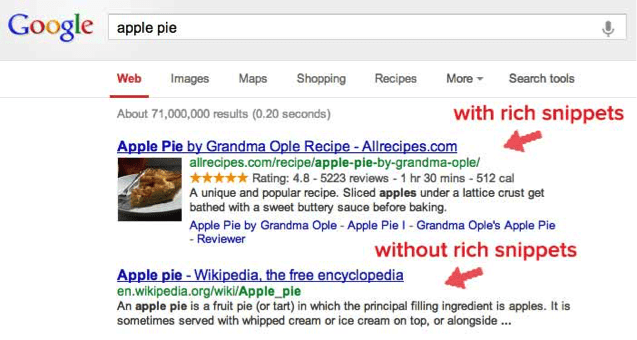
Add a Mix of Relevant Images
Visual elements break up text and enhance user engagement. Content with relevant images receives, on average, 94% more views than text-only content. Infographics are particularly effective in conveying complex information.
But text alone is boring and monotonous. And people have shorter attention spans than ever.
Did you know that the brain processes visual information 60,000 times faster than text? 93% of communication is nonverbal and 65% of the population are visual learners.
This is all the more reason for you to include visuals and videos to improve the experience that your visitors have.

Paragraph Length and Readability
Shorter paragraphs, with no more than four or five sentences, contribute to enhanced readability. Google rewards content that aligns with user-friendly reading patterns. Additionally, writing content at a 5th-grade level ensures accessibility for a broader audience.
People also like to scan content.
But if paragraphs are too long, the words are too difficult, and/or the sentences are too long, users can’t do that!
However, when it’s easier to read, people will favor that content.
And they are going to be more likely to go back to your content in the future.
Add Video Clips
Incorporating relevant video clips into your blog posts enhances engagement and time spent on page. Pages with videos are 53 times more likely to rank on the first page of Google.
Use Transition Words and Phrases
Transition words improve the flow of your content. Including words like “however,” “moreover,” and “furthermore” contributes to a more coherent and reader-friendly narrative.
You can use other transition words and phrases to improve readability, such as:
- And
- But
- Therefore
- Then
- Further
- As a result
- As you can see
8) User Experience
Lower Your Bounce Rate
A lower bounce rate signifies that visitors are finding your content relevant and engaging. Factors such as compelling content, easy navigation, and quick page load times contribute to a positive user experience. Did you know that a one-second delay in page response can result in a 7% reduction in conversions?
Use Scroll Maps and Heatmap Software
Understanding how users interact with your site is crucial. Scroll maps and heatmap software provide insights into user behavior, allowing you to optimize the placement of key elements on your pages. Pages with strategic element placement experience, on average, a 30% increase in conversion rates.
Hotjar and CrazyEgg are two popular tools for this.

Be Careful with Interstitial Ads
While interstitial ads may boost lead generation, they can negatively impact your Google rankings.
What is an interstitial ad?
An interstitial ad is a type of online advertising that appears between two content pages, often as a full-screen overlay or pop-up. Unlike traditional banner or display ads, interstitial ads take up the entire screen, providing a more immersive and attention-grabbing experience for users.
Interstitial ads are typically displayed at natural transition points, such as between levels in a game, during the pause in an app, or between articles on a website. They aim to capture the user’s attention during moments when they are likely to be more engaged and receptive to advertising content.
It’s worth noting that while interstitial ads can be effective in terms of visibility, they can also be perceived as intrusive by some users. As a result, their use should be balanced carefully to avoid negatively impacting the user experience.
Google considers full-screen ads that cover the interface disruptive. Striking a balance between lead generation and user experience is vital for sustained SEO success.
However, you may find success in timing your full-screen overlay to pop up after 15 or 20 seconds. This may improve time on-page and web crawlers may not pick it up if the page is crawled before the time elapses.
But it may also decrease views, and as a result, conversions into leads. So make sure you run some tests and see how things go!
Minimize Pop-Ups
Pop-ups, if not used judiciously, can hinder user experience. Intrusive pop-ups can lead to increased bounce rates and lower search engine rankings. Employing user-friendly pop-ups that add value can positively impact user engagement. You can also embed your offers rather than use popups. This will be far less annoying for your users and will not degrade certain ranking factors.
Implement SSL
Security is a crucial aspect of user trust. Implementing SSL (Secure Sockets Layer) not only secures data transmission but also contributes to higher search engine rankings. Google considers HTTPS as a ranking signal.
Create Friendly 404 Pages
A well-designed 404 page provides a positive user experience when users encounter broken links or unavailable content. Users who encounter a friendly 404 page are more likely to explore other parts of your site rather than immediately leaving.
Make Your Site Mobile-Optimized
Given the prevalence of mobile device usage, optimizing your site for mobile is imperative. Mobile-optimized sites not only enhance user experience but also receive preferential treatment in Google’s mobile-first indexing. Nearly 60% of searches are now from mobile devices.
Set Your Image Dimensions
How does setting image sizes affect page experience and SEO?
Setting image size dimensions are important because it creates a greater ability for those images to shift properly, based on browser width, height, and screen size. It affects what’s called CLS, or cumulative layout shift, which is a ranking factor for your website. As you retract and expand your browser, your content will shift. CLS is also affected by viewport sizing.
If you don’t have set image dimensions, your images will not shift properly and will create a more clunky user experience, which negatively impacts CLS.
What’s a good cumulative layout shift (CLS) score?
You ideally want your CLS to be under 0.1 for 75% or more of your pages.
How do I find my cumulative layout shift (CLS) score?
You can find your CLS by going to going to the Google Search Console, navigating to the Experience dropdown menu, clicking on “Core Web Vitals” and then clicking on “OPEN REPORT >” for either Desktop or Mobile.
9) Google Search Console, A.K.A. Google Webmaster Tools
See What Keywords and Queries People Use to Find You
Google Search Console provides invaluable insights into the keywords and queries that lead users to your site. Understanding user search behavior allows you to tailor your content to meet their needs.
Did you know that 15% of daily searches on Google are entirely new?
View Your Rankings for Each Keyword
Monitoring your rankings for specific keywords enables you to assess the effectiveness of your SEO strategies. Improvements in rankings can lead to increased visibility and traffic. Websites ranking on the first page of Google receive, on average, 71% of all clicks.
Update Google’s Indexes
Keeping your site’s content up-to-date is essential. Google Search Console allows you to request a re-crawl of specific pages, ensuring that the latest changes are reflected in search results. Pages that are regularly updated tend to have higher visibility.
Use the Data Highlighter
If applicable to your content, using the Data Highlighter in Google Search Console helps enhance the display of rich snippets in search results. Pages with rich snippets receive, on average, a 30% higher click-through rate.
Re-Index Updated Pages/Posts with URL Inspection Tool
When you update your content on a page or post, make sure you re-submit it in the search console. You do this by clicking on URL inspection and clicking the text, “REQUEST INDEXING.” This adds it to a priority crawl queue and usually updates within 24 hours or less.
10) Google Analytics
Monitor Your Organic Traffic and Its Changes
Google Analytics provides a comprehensive view of your website’s traffic sources. Monitoring organic traffic and its changes over time helps you understand the impact of your SEO efforts. Did you know that websites with strong organic traffic tend to have a lower bounce rate?
Analyze Your Landing Page Metrics and Time on Page Metrics
Analyzing landing pages and time spent on each page offers insights into user engagement. Pages with longer average time on page metrics are more likely to rank higher on search engine results.
The average time spent on a page is around 15 seconds, highlighting the importance of capturing user attention quickly.
However, the average time spent is a literal average across all pages, with many just having one second time on page before users bounce. So those 15 seconds are not representative of what a quality time on page is supposed to look like.
Embedding highly relevant videos will certainly help increase your time on page metrics.
See Where Visitors Exit
Identifying exit points on your site allows you to pinpoint potential issues in user experience or content. Addressing these points can reduce bounce rates and increase user retention. Pages with lower bounce rates are more likely to rank higher on search engines. You can use heatmapping tools to find this information or you can find it within Google Analytics 4 (GA-4).
With GA-4, you can find a tutorial for it here.
View How Your Posts Do via the Content Drill Down
The Content Drill Down feature in Google Analytics provides a granular view of how specific posts or content categories perform. Understanding the success of individual posts helps you tailor your content strategy for optimal results.
Learn About Your Visitors for Better Content Creation
Google Analytics offers demographic and interest data about your audience. Utilizing this information allows you to create content that resonates with your target demographic. Customized content that’s geared to your audience is more likely to engage users and contribute to higher search engine rankings.
11) Site Speed
Reduce Image Sizes for Decreased Site Load Time
Optimizing images by reducing their sizes enhances site speed. Fast-loading pages improve user experience and contribute to higher search engine rankings. Did you know that 47% of users expect a web page to load in two seconds or less? Thus, it makes sense not to use large images at full resolution. Re-size them in Photoshop, Inkscape, Canva Pro, Image Preview app on MacOS or even Microsoft’s Paint 3D app via the Canvas section.
Enable Image Compression with WordPress Plugins or External Tools
Plugins for WordPress automate the image compression process, reducing the file sizes without compromising much quality. Compressed images contribute to faster page load times, positively impacting both user experience and SEO. In WordPress, search the plugins marketplace for “image compression tools.” You’ll find what you need.
However, if you don’t use WordPress, don’t worry! There are other options for you. Check out these 7 Image Compression Tools roundup post.
Use CSS Compression
Compressing CSS files reduces the overall page load time. Faster loading pages have a direct correlation with lower bounce rates and higher user satisfaction. Studies show that 53% of mobile site visitors leave a page that takes longer than three seconds to load.
Eliminate Render-Blocking JavaScript & CSS
Eliminating render-blocking JavaScript & CSS will decrease load times and increase your site speed, improving user experience.
There are three ways to do this:
- You can make them non-render blocking by deferring their download.
- Reduce the total number of render blocking resources using techniques such as bundling (this also means fewer HTTP requests)
- Reduce the size of a resource via minification so that the page has fewer bytes to load
You can achieve these tasks in WordPress by utilizing caching plugins (only available in those when you pay) and specialty freemium plugins like Async JavaScript and Autoptimize (both by the same company).
If you’re not using WordPress, check out these 9 tricks to eliminate render-blocking resources.
Increasing your site speed with these tactics will be great for your SEO efforts!
Enable HTML Compression
HTML compression minimizes the size of HTML files, resulting in faster loading times. Google considers page speed as a ranking factor, and websites with faster load times tend to rank higher in search results.
Explore “Above the Fold Optimization”
Above the fold optimization ensures that critical content is visible without scrolling. Software to enhance the loading speed of the initial page view certainly helps with that. Faster rendering of above-the-fold content contributes to improved user satisfaction.
Explore “Accelerated Mobile Pages” Plugin for WordPress
AMP (Accelerated Mobile Pages) plugins optimize pages for mobile viewing, enhancing load times on mobile devices. Given the prevalence of mobile searches, mobile-optimized pages contribute significantly to SEO success. However, it is a freemium tool with limited free features. And, Gutenberg optimizes blog content for mobile quite well now. So unless you want one of their premium AMP themes, Gutenberg is the way to go.
Avoid Unnecessary WordPress Plugins
Each WordPress plugin adds to the overall page load time. Deactivating unnecessary plugins, which do not contribute significantly to functionality, helps maintain optimal site speed. Lean websites with minimal plugins tend to load faster.
Explore “W3 Total Cache” and WP Rocket Plugins for WordPress
W3 Total Cache is a comprehensive caching plugin for WordPress that’s freemium (and less user-friendly). WP Rocket is a paid-only tool but it’s very user friendly and very good. Caching plugins store static versions of pages, reducing server load and improving site speed. Pages that load quickly have higher user satisfaction and are more likely to rank well in search results.
Analyze Website Page Speed with GTMetrix, Google PageSpeed Insights, and Alternatives
While GTMetrix is freemium, Google PageSpeed Insights is totally free, and alternatives are out there too that are free. Utilizing a combination of these tools will provide you with better insights into how fast your website is, and what, in particular, is slowing it down.
Using these tools and correcting the underlying causes of high load-times is a journey and endeavor that’s very time consuming. If you have a large WordPress site, and you’re working to recursively fix your page speed problems, it can take you weeks to optimize it.
However, once you get it under control, you’ll have a much smoother experience from there on.
Avoid Putting Large Files on Pages
Large files, such as images or videos embedded directly on pages, can slow down load times. Utilizing links to these files instead of embedding them directly contributes to faster page rendering. Improved page speed positively impacts both user experience and SEO.
Image Optimization
Add Relevant “Alt Text” Using Target Keywords
Adding descriptive and relevant “alt text” to your images using target keywords provides context to search engines. Alt text improves accessibility for users with disabilities and contributes to better image search optimization. Did you know that images with alt text are more likely to appear in Google’s image search results?
Create Descriptive File Names
Naming image files with descriptive and keyword-rich names helps search engines understand the content of the image. Descriptive file names improve image SEO and contribute to higher rankings. Images with relevant file names are more likely to be considered for featured snippets.
Utilize Image Compression for Faster Loading
Compressing images without sacrificing quality is crucial for both site speed and user experience. Tools like “EWWW Image Optimizer” (for WordPress users) or standalone options help reduce file sizes, ensuring faster loading times. Faster-loading images positively impact bounce rates and SEO rankings.
Consider Lazy Loading for Improved Page Speed
Implementing lazy loading delays the loading of off-screen images, improving initial page load times. This technique is especially beneficial for pages with numerous images. Google recognizes lazy loading as a user-centric practice, positively influencing search engine rankings.
Utilize Responsive Images
Responsive images adapt to different screen sizes, providing an optimal viewing experience across devices. Google considers responsive design a ranking factor. Websites with responsive images are more likely to rank well in mobile search results.
Leverage Image Sitemaps
Including images in your XML sitemap helps search engines index and understand the content of your images. Image sitemaps provide additional context, contributing to improved image search rankings. Properly indexed images enhance overall website visibility.
13) Social Media
Strategic Social Media Sharing
Share your posts strategically on social media platforms, emphasizing platforms where your target audience is most active. Google takes social signals into account, and posts with higher social engagement are likely to rank higher.
Optimize Your Google Business Profile for Local SEO
For local businesses, optimizing your Google Business Profile enhances local search visibility. Include accurate business information, respond to reviews, and upload relevant photos. Local SEO is crucial for attracting nearby customers. You can manage your Google Business Profile here.
Explore Rich Pins on Pinterest
Utilize rich pins on Pinterest to enhance the visibility of your content. Rich pins provide additional information directly within Pinterest, attracting more engagement. Pinterest can be a powerful source of referral traffic.
Encourage Social Sharing
Encourage your audience to share your content on social media. Social shares contribute to increased visibility and potential backlinks. Posts with higher social shares often gain more traction in search engine rankings.
Participate in Quora and Reddit Discussions
Engage in discussions on platforms like Quora and Reddit, providing valuable insights and linking back to your relevant posts. These platforms can drive targeted traffic and contribute to improved search engine rankings.
14) Google Penalty Recovery
Check for Traffic Drops
Regularly monitor your website’s traffic for any sudden drops. Significant traffic declines could indicate a Google penalty. Use tools like Google Analytics to track traffic changes over time. Did you know that around 65% of penalized sites recover within one month of addressing the issues?
Remove Broken Links and Bad Links
Broken Links
Identify and remove any bad or broken links on your website. Broken links negatively impact user experience and can lead to penalties from search engines. Regularly conduct link audits using tools like Google Search Console.
Once you fix broken links to external or internal pages that are no longer existing, re-scan the page/post with the URL inspection tool.
Bad Links/URLs
You have to remove bad URLs that no longer exist on your website so you don’t get penalized anymore. Go to the “Removals” tool under “Indexing” on the left menu pane of Google Search Console and click the red “New Request” button and put the URL in. They’ll usually take a few days to be removed from Google.
Address Thin Content
Thin content lacks substance and value. Either remove or improve thin content pages on your site by adding detail and depth to it. Add pictures and statistics. Make it educational, demonstrate your experience and expertise through the content whenever possible. Make it authoritative, and make it trustworthy. These are the core tenets of E-E-A-T. Google favors high-quality content, and addressing thin content can positively impact search engine rankings. Pages with comprehensive content tend to rank higher.
15) Content Promotion
Leverage Diverse Traffic Channels
Promoting your content across various channels increases visibility and drives diverse traffic. Share on social media, email newsletters, relevant forums, and industry-specific platforms. Diversifying your promotion strategy contributes to a broader audience reach.
Utilize Shareable Assets like Infographics
Create shareable assets, such as infographics, that complement your content. Infographics are highly shareable and can attract backlinks. Visual content is engaging, and posts with infographics are more likely to be shared on social media, amplifying your content’s reach.
Email Promotion for Traffic and Repeat Visitors
Promote your content via email to your subscriber base. Email marketing not only attracts more traffic but also encourages repeat visitors. Google recognizes consistent traffic and engagement, positively impacting domain authority and search rankings.
Engage in Reciprocal Content Sharing
Share other people’s content on your platforms, especially when it’s relevant to your audience. Engaging in reciprocal content sharing encourages others to reciprocate, leading to increased visibility and potential collaborations. Google views a well-connected online presence positively.
16) General SEO Tips and Advice
Stay Informed about SEO Trends
Continuously educate yourself about the evolving nature of SEO. Stay updated on algorithm changes and industry trends. Google frequently updates its algorithms, and staying informed allows you to adapt your strategies for optimal performance.
Avoid Spammy Practices
Resist the temptation to engage in spammy practices, as they can harm your site’s reputation. Create context when marketing your posts, and ensure that your content aligns with user intent. Google and users appreciate genuine, contextually relevant content.
Examples of spammy practices to avoid include:
- Keyword Stuffing: Overloading your content with excessive keywords in an attempt to manipulate search engine rankings is considered spammy. Instead, focus on natural and contextually relevant keyword usage.
- Cloaking: Presenting different content or URLs to search engines and users with the intent to deceive is known as cloaking. It violates search engine guidelines and can result in penalties.
- Link Buying: Purchasing backlinks from dubious sources to artificially inflate link metrics is a spammy practice. Quality backlinks should be earned through valuable content, not bought.
- Hidden Text and Links: Concealing text or links by making them the same color as the background or using tiny font sizes is deceptive. Search engines penalize websites employing such tactics.
- Duplicate Content: Copying content from other sources or within your own site without providing added value is considered duplicate content. It can lead to ranking issues and reduced visibility.
- Spam Comments and Backlinks: Posting irrelevant or automated comments on blogs and forums solely for the purpose of including backlinks is spammy. Genuine engagement is favored over automated link-building schemes.
- Misleading Redirects: Redirecting users to a different page than the one they expected, especially for deceptive purposes, is against search engine guidelines. Redirects should be transparent and user-friendly.
- Automated Content Generation: Using automated tools to generate low-quality or nonsensical content is a spammy practice. Content should be valuable, relevant, and created for human readers.
- Intrusive Interstitials: Displaying intrusive pop-ups or interstitial ads that disrupt user experience is considered spammy. Google penalizes websites that use such practices.
- Fake Reviews: Creating fake reviews or testimonials to boost online reputation is unethical and can lead to penalties. Authenticity is crucial for building trust with users and search engines.
Maintain Context in Content Marketing
When promoting your posts or site, provide context. Explain why you wrote a specific post or started your startup. This additional context not only builds a connection with your audience but also enhances the credibility of your content in the eyes of search engines.
Reciprocal Relationships for Backlinks
When engaging in backlink-building activities, foster reciprocal relationships. If someone requests a backlink from your site, consider proposing a mutual agreement. Offer to link to their site in return for them marketing your post or page containing the new backlink.
Gutenberg for Mobile Optimizations
For WordPress users, leverage the mobile optimization features of Gutenberg, the block editor. Gutenberg inherently ensures responsive and mobile-friendly designs, minimizing the necessity for AMP (Accelerated Mobile Pages). Mobile-optimized content positively influences search rankings.
Offer Value for Backlink Requests
When someone requests a backlink from your site, consider offering additional value. Propose that if they add a link to their site, you will actively market the post or page containing the new backlink. This mutually beneficial approach strengthens relationships and enhances content visibility.
Local SEO Strategies
If your startup has a physical presence or serves a local audience, consider implementing local SEO strategies. This involves optimizing for local keywords, managing your Google Business Profile, and encouraging customer reviews.
Schema Markup
Enhance the visibility of your content by implementing schema markup. This not only aids search engines in understanding your content but also improves the appearance of rich snippets in search results.
Video Content Optimization
If your startup produces video content, optimize it for search engines. Use descriptive titles, add relevant tags and metadata, and provide transcriptions for videos to improve discoverability.
Competitor Analysis
Stay ahead in the competitive landscape by periodically conducting competitor analysis. Understanding industry trends and competitor strategies can guide your SEO efforts and uncover new opportunities.
SEO Tools to Use
Google Trends, SEMrush, Search Engine Land
- Stay informed with Google Trends or SEMrush: Keep track of evolving SEO trends and changes in user search behavior.
Moz or Majestic
- Monitor backlink profiles with Moz or Majestic: Understand the link landscape of your website and competitors, identifying opportunities for link building.
Screaming Frog SEO Spider
- Perform website audits with Screaming Frog SEO Spider: Identify issues related to on-page SEO, broken links, and other technical aspects for improved website health.
Google Analytics
- Analyze website traffic with Google Analytics: Gain insights into user behavior, track organic traffic, and monitor the performance of specific pages.
Ubersuggest, Google Ads Keyword Planner, AnswerThePublic, or AI Chatbots
- Generate content ideas with Ubersuggest, Google Ads Keyword Planner, AnswerThePublic, or AI Chatbots: Uncover relevant topics and questions that your audience is searching for to create valuable and targeted content.
BuzzSumo
- Analyze content performance with BuzzSumo: Understand what content is trending in your industry, identify influencers, and refine your content strategy.
Rank Math (WordPress Plugin)
- Optimize content with Rank Math: For WordPress users, Rank Math is an SEO plugin that provides on-page SEO analysis, helping you optimize content for search engines.
CoSchedule Headline Analyzer
- Craft compelling headlines with CoSchedule Headline Analyzer: Ensure your headlines are engaging and optimized for click-through rates.
17) Recurring Activities for Sustained SEO Success
Achieving and maintaining optimal search engine rankings is an ongoing process that requires consistent attention and strategic efforts. Incorporate these recurring activities into your SEO routine to ensure sustained success:
- Regular Content Updates: Periodically review and update existing content to reflect current information and maintain relevance.
- Keyword Monitoring and Adjustment: Monitor keyword performance using tools like Google Analytics, Google Search Console, or third-party SEO tools. Adjust content to align with evolving search queries.
- Backlink Analysis and Building: Regularly monitor and analyze your backlink profile. Seek opportunities to build high-quality backlinks for improved authority.
- Technical SEO Audits: Conduct periodic technical SEO audits to identify and resolve issues that may impact site performance in search results.
- Performance Monitoring: Regularly monitor website performance, including page load times and mobile optimization, to enhance user experience.
- User Engagement Analysis: Analyze user engagement metrics such as bounce rate, time on page, and click-through rates. Optimize content based on user behavior.
- Social Media Promotion: Share and promote content on social media platforms to increase visibility and attract organic traffic.
- Competitor Analysis: Regularly analyze competitor strategies, keywords, and content to stay competitive and adapt to industry trends.
- Monitoring Algorithm Updates: Stay informed about major search engine algorithm updates. Adapt strategies to align with search engine guidelines.
- Local SEO Optimization: Optimize for local search by managing your Google Business Profile and obtaining local citations for enhanced local visibility.
- User-Generated Content: Encourage and engage with user-generated content, such as reviews and comments, to add credibility and influence search rankings.
- Regular Reporting and Analysis: Generate and review SEO reports regularly to track progress, identify areas for improvement, and adjust strategies accordingly.
Conclusion: Mastering SEO for Sustainable Growth
Congratulations! You’ve just embarked on a journey to supercharge your startup’s online presence with our comprehensive SEO checklist. As idea-stage founders, pre-seed and seed-stage startups, and early-stage marketers, you now hold the key to unlocking the true potential of your digital strategy.
Remember, the world of SEO is dynamic, and staying ahead is an ongoing process. Regularly revisit this checklist, adapt to the ever-evolving search engine landscape, and continue providing valuable, user-centric content.
By optimizing your site layout, conducting thorough keyword research, and ensuring an impeccable user experience, you’re not just improving rankings — you’re creating a foundation for sustained success. Leverage the power of analytics, stay attuned to industry trends, and refine your approach based on insights gained.
StartupDevKit is here to guide you at every step. Embrace these SEO principles, and witness the growth of your startup’s online visibility. Now, go conquer the digital realm with confidence and drive organic traffic to new heights!
Ready to dive deeper into the world of startup development? Explore more resources on StartupDevKit and stay ahead in the dynamic landscape of entrepreneurship.
Best of luck on your journey to SEO excellence!


